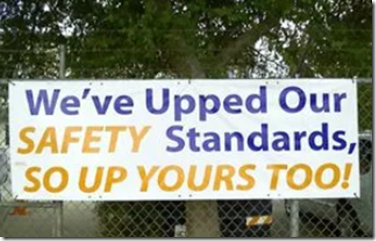Originally posted on January 19, 2021 @ 6:16 AM
The Seduction of Slogans in Safety

· Slogans are a form of rhetoric and are not neutral or objective. All slogans hide an ideology, politic and intent by turning a complex issue and ethic into a simplistic aphorism. In this way, a slogan convinces people of an argument or state that has been simplified and is most often not true. Certainly, slogans are not true if you consider the complexities behind the slogan. For example, in 2015 the then Prime Minister Tony Abbott simplified the complex issues of refugees, borders, asylum seekers and people smuggling with a three-word slogan ‘stop the boats’. Abbott in particular was the master of the three-word slogan. In a similar way Trump used slogans like ‘build that wall’, ‘drain the swamp’ and ‘stop the steal’ to rally support and drum up chants at his rallies.
· Slogans are unique because they contain a degree of musicality. They usually include a clever use of metaphor, rhythm, rhyme or metonym that can be chanted or remembered easily. In this way the slogan gains power over normal prose or narrative just like the lyrics of a song are recalled. Slogans though simple, hide a complex history and shape belief unconsciously. This is particularly true for people who don’t read or think critically.
· Slogans are a form of reductionism and attract people to simple black and white ways of thinking that can be marketed or become a brand. In this way slogans are often part of propaganda and political ‘spin’. The slogan then becomes a slick way of ‘anchoring’ in a group, cult or club.
· Slogans have no meaning or purpose beyond themselves to garner support and build a base. The chant or slogan them becomes a shibboleth that tests membership to a group and the meaning of the slogan is never challenged. We see this with safety slogans like ‘zero harm’, ‘safety is a choice you make’ and ‘all accidents are preventable’ or ‘you can’t manage what you can’t measure’. In the end these types of slogans are made an unconscious shibboleth for cult membership. The jargon of the club or cult actually has no meaning other than to determine in-group or out-groupness. Such a notion of belonging makes discrimination of the enemy easy and simple. For example, any challenge to zero harm becomes the enemy of safety and the simplistic binary question is then asked: ‘how many people do you want killed today?’
· Slogans are also a semiotic and invoke a semiosis (meaning making). All semiotics play a fundamental role in cultural formation and reproduction and do so unconsciously. It is often all the powerful things that are hidden in the background in the use of a slogan that make slogans seductive. The musicality of a slogan carries a form of sound symbolism and synesthesia that is undetected to the uncritical Mind. In this way slogans shape perception and serve a filter for belonging to a group that accepts a slogan uncritically.
So, whilst it is neat and easy to use slogans to capture a following of an initiated group, we also need to be most wary of the ways in which slogans work and always sustain a critical Mind in how they are used.



Rob Long says
Yep Rob, a good slogan saves a whole lot of critical thinking, especially when anchored to a clever semiotic.
Bernard Corden says
Another three-word slogan from our ecclesiastical PM and the federal treasurer is “Jobs and Growth”.
The reality in an era of catabolic capitalism is widespread underemployment via a gig economy offering mundane McJobs, which involves exploitation of many temporary migrants and other vulnerable workers. It merely socialises the loss and secures the interests of the powerful over the powerless.
“A rubbish dump can grow without developing although a person can develop without growing” – Russell L Ackoff
“Our obligation is not to mistake slogans as solutions” – Edward Murrow
Rob Schroder says
Great blog Rob, very interesting to look for the icons linked with the slogans and the associated semiotics created. There were a multitude of these during the march on the Capitol building.